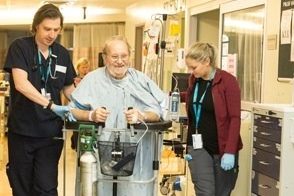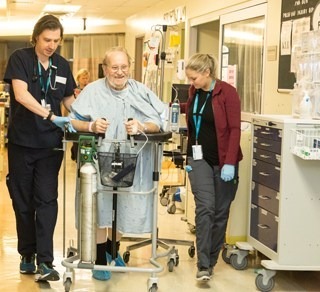MOVE TO IMPROVE: EARLY REHABILITATION IN CRITICAL CARE THE FOCUS OF PILOT PROJECT

By Greg Winson
Jan. 9, 2019 – For patients admitted to the Intensive Care Unit, early mobility can be a key factor to a successful recovery. Now a pilot project underway at St. Michael’s and St. Joseph’s will study how to implement early mobility in the ICU environment and provide a standardized toolkit of best practices to critical care units across the province.

The Provincial Early Rehabilitation in Critical Care (PERCC) initiative is a partnership between St. Michael’s and Critical Care Services Ontario.
“Maintaining strength is very important,” said Dr. Andrew Baker, chief of the Critical Care department at St. Michael’s. “It allows one to maintain activities of daily living, everything from getting out of a chair, taking care of one’s own personal needs, eating meals independently, and of course being able to enjoy activities with one’s family like walking and shopping.”
Maintaining strength has the potential to reduce the length of stay in hospital, and reduce or eliminate the need to go to a rehabilitation hospital as part of recovery.
Early mobility represents a shift from the traditional concept of a patient resting and recovering before undergoing any sort of rehabilitation.
“It doesn’t always seem intuitive, because you think, if someone’s really sick they need to rest,” said Deanna Feltracco, a physiotherapist in the Medical Surgical Intensive Care Unit at St. Michael’s. “But it’s actually good for patients to get up and mobilize.”
The shift has been embraced at both sites and had been put into practice prior to the PERCC pilot project.
“Our culture has been very mobility-driven,” said Shannon Swift, clinical nurse educator in the MSICU at St. Michael’s. “We had previous guidelines in place, so this project involved formalizing and continuing to improve, creating a 2.0 version.”
Each patient receives a chart with a number based on what they achieved in their mobility session, ranging from passive bed exercises to walking independently. The chart, posted at the bedside, shows patients their progress.
“Before, patients wouldn’t know what their rehab goals were,” said Danny Slack, a physiotherapist in the Intensive Care Unit at St. Joseph’s. “Now patients and their family members can see the target goals for the day.”
Both St. Michael’s and St. Joseph’s have additional physiotherapy coverage as part of the pilot, which is making a difference.
“We’re able to see more patients, see patients twice a day,” said Slack. “This speeds up recovery times, especially for more complex patients.”
The early rehabilitation concepts learned during the pilot will inform a plan to roll out protocols to intensive care units throughout Ontario.
“The primary objective is to help patients,” said Dr. Baker. “The goal is to get patients better sooner.”
